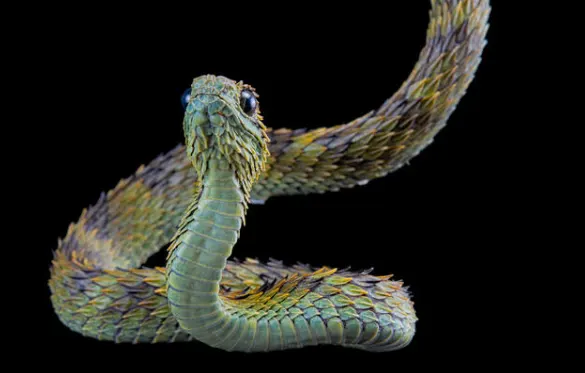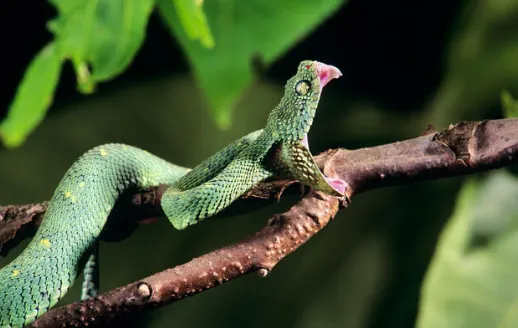The spiny bush viper (Atheris hispida) is a remarkable and visually striking species of snake native to the rainforests of Central Africa. Known for its unique appearance and potent venom, this arboreal viper captivates both herpetologists and snake enthusiasts alike. Let’s delve into the intriguing characteristics, behavior, and habitat of this fascinating reptile.
Table of Contents
Appearance and Physical Characteristics
The spiny bush viper, also known by several other names such as the African hairy bush viper, rough-scaled bush viper, and bristly bush viper, is a small yet formidable snake. Males typically reach lengths of about 29 inches, while females are slightly smaller, averaging around 23 inches. These snakes are characterized by their elongated, strongly keeled scales, which give them a shaggy or spiny appearance. This distinctive scalation serves as excellent camouflage, helping them blend seamlessly into the bushy trees and shrubs they inhabit.
Color Variations: Their coloration can vary significantly, ranging from green and blue to brown, or even a combination of these hues. This variation often leads to confusion with other species. The spiny bush viper has a slender body, large eyes with vertical pupils, and a prehensile tail that aids in climbing and hanging from branches. As vipers, they possess retractable fangs connected to venom glands, which are capable of delivering a potent bite.

Behavior and Lifestyle
Nocturnal Habits: Spiny bush vipers are primarily nocturnal creatures, spending their days resting in the dense foliage of trees and shrubs. They are excellent climbers and are predominantly arboreal, spending most of their lives off the ground. These vipers are ambush predators, using their exceptional camouflage and prehensile tails to remain hidden while waiting for prey to come within striking distance. They feed mainly on frogs and lizards but also consume small mammals, birds, and snails.
Despite their fearsome appearance and potent venom, spiny bush vipers are not generally aggressive. They prefer to avoid confrontation and will typically flee if threatened. However, when cornered, they will defend themselves vigorously.
Habitat and Distribution
Geographical Range: The spiny bush viper is native to the rainforests of Central Africa, including countries like Uganda, Kenya, and the Democratic Republic of Congo. These snakes are found at altitudes ranging from 2,952 to 8,200 feet (900 to 2,500 meters) above sea level. They inhabit both primary and secondary forests, as well as cultivated shrublands, showing a degree of adaptability to different environments.
Their distribution is somewhat fragmented, with populations appearing in isolated pockets. This fragmented distribution makes it challenging to conduct comprehensive studies on their population and behavior. However, it is known that they thrive in regions with abundant vegetation and bodies of water, which provide both habitat and
Venom and Danger
The venom of the spiny bush viper is highly potent, though its exact nature is still a subject of research. Some studies suggest that it is neurotoxic, while others indicate it may be hemotoxic. The venom composition can vary depending on the snake’s diet and region. Regardless of the specifics, it is clear that their venom is dangerous, and there is no known antivenom available. This makes bites from these snakes potentially fatal, although encounters with humans are relatively rare due to their remote habitats.
Conservation Status and Threats
The spiny bush viper is currently classified as “Least Concern” by the IUCN Red List of Threatened Species. This classification is due to their wide distribution and the general lack of major threats to their populations. However, habitat destruction, particularly due to deforestation, poses a potential risk to their numbers. Ongoing research and conservation efforts are crucial to monitor their status and ensure their continued survival in the wild.

Reproduction and Lifespan
Spiny bush vipers reach sexual maturity at around 2-3 years of age. They mate during the rainy season between September and October. Females have a gestation period of 6-7 months and give birth to live young, with litter sizes ranging up to 12 neonates. These newborns measure about 6 inches at birth and are fully independent from the moment they are born. In captivity, spiny bush vipers can live for 10-12 years, though their lifespan in the wild is less well-documented.
The spiny bush viper is a captivating species that highlights the incredible diversity of the natural world. Its unique appearance, arboreal lifestyle, and potent venom make it a subject of fascination and study. Understanding and preserving such species is vital, as they play important roles in their ecosystems and contribute to the biodiversity of our planet. As researchers continue to explore the intricacies of the spiny bush viper, we gain greater appreciation and knowledge of these remarkable reptiles.
FAQs
Are Spiny Bush Vipers venomous?
Yes, spiny bush vipers are highly venomous.
Are Spiny Bush Vipers aggressive?
Not generally, but they will defend themselves if threatened.
Do Spiny Bush Vipers make good pets?
They are not recommended as pets due to their potent venom and specialized care requirements.
How do Spiny Bush Vipers hunt?
They use ambush tactics, relying on their camouflage to catch prey.
Where do Spiny Bush Vipers live?
They inhabit the rainforests of Central Africa, including Uganda, Kenya, and the Democratic Republic of Congo.
- Enchi Ball Python: A Unique and Stunning Morph of Python regius - March 27, 2025
- Emerald Tree Monitor: The Enigmatic Green Guardian of the Rainforest - March 26, 2025
- The Egyptian Cobra (Naja haje): A Fascinating Serpent - March 25, 2025
